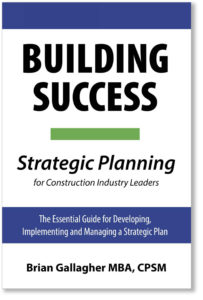While it may be boring or unsexy, planning is an important step in the road to success. I like to think the phrase, “failing to plan is planning to fail,” describes the importance of planning well. There may be some industries where a strategic plan may not be important, but I can’t think of one. Facility management is an industry that requires careful planning and the development of continuous improvement habits. Facility managers assume responsibility for the constructed infrastructure, and do what is needed to keep the facility serviceable and a valued product for the owner, customers, and visitors. Enjoy learning more about the development of a meaningful strategic plan.
Building Success: Strategic Planning for Construction Industry Leaders
Gallagher, Brian, self-published (www.BrianPGallagher.com), Greenville, SC, 2024, 173 pages, e-book, $10; softcover, $25; hardcover, $30.
 Facility organizations are a combination of planning, design, construction, operations, and maintenance functions. All require a clear, coordinated plan to function effectively. The overall goal is to add value and support the mission of the lead organization. Being a follower may work in the short run, but being successful requires deeper, strategic thinking.
Facility organizations are a combination of planning, design, construction, operations, and maintenance functions. All require a clear, coordinated plan to function effectively. The overall goal is to add value and support the mission of the lead organization. Being a follower may work in the short run, but being successful requires deeper, strategic thinking.
In Building Success: Strategic Planning for Construction Industry Leaders, Brian Gallagher leverages his knowledge and experience to provide recommendations to construction company leaders to assist with the growth of their business. The first question that might be asked is: “why does this apply to facility leaders?” While construction work may be a small part of the mission of a facility organization in education, it is one part and applicable to other parts.
APPA has long been a proponent of several references that Gallagher cites in Building Success—Covey, Collins, and Sinek are three of the referenced authors who are focused on developing strong organizations and who’s books have been reviewed by this column. Covey is a clear match with his admonitions to: “Be proactive.” “Begin with the end in mind.” “Think win-win.” and “Synergize.” A strategic planner needs to do all these—and more—to be successful. They are big picture issues required to develop a successful strategic plan.
This book is focused on construction companies, not operations and maintenance (O&M) organizations. However, even O&M organizations need to pay attention to the forces, within the institution and outside, that drive customers and budgets. Facility leaders must attend to the daily issues while keeping an eye on those issues that move the organization forward and, of course, recognize the difference. That is, facility leaders respond appropriately to the constant and changing conditions of the campus to ensure customer services are maintained. But, beyond daily customer service, facility leaders should also pay attention to other campus issues such academic program growth and where the campus may be growing.
After a relatively lengthy initial section, where Gallagher lays the groundwork and cites references, the second section provides the “How To” in nine short chapters describing each step to follow and what to include in both data-gathering and plan development to create a successful strategic plan. This is where the foundation of Covey, Collins, and Sinek is laid. This part is valuable for anyone who understands the need for, and wants to develop, a strategic plan. These chapters include identification of participants to develop the plan, who will execute the plan, and what is necessary to measure the progress and success of the plan. Despite the number of chapters, this is the four-step PDCA (plan-do-check-act) cycle necessary to create and operate a successful strategic plan.
Creating the continuous improvement planning cycle is not the only information needed. The third part of book identifies several tools that can be used to develop the plan (P), measure the plan (C), and respond to deviations in the plan (A). Many of these are the more difficult elements of a strategic plan, especially for those who accept the need for a plan and understand how to develop the plan but don’t know how to “read the tea leaves” as it is executed and how to take the needed corrective actions to keep the plan moving forward while maintaining the ground-level support for the plan.
For those who want the details, the appendix includes references to the supporting documents. Overall, Building Success is a helpful reference that consolidates the background, steps, and tools needed to create a successful plan to move the organization forward. It’s readable and allows the reader to focus on needed information while also providing everything needed for a reader with no knowledge of strategic planning. In an environment where facility leaders struggle to maintain budgetary support and motivate the workforce, Building Success is an excellent resource.
APPA Fellow Theodore (Ted) Weidner, PhD, PE, RA, NCARB, DBIA, CEFP, is professor of engineering practice at Purdue University, West Lafayette, Indiana, and consults on facilities management issues primarily for educational organizations. He can be reached at [email protected]. If you would like to write a book review, please contact Ted directly.
Bookshelf
Book reviews on current publications relevant to the profession, trends, and working environment of facilities and educational managers and professionals. To contribute a book review, contact Ted Weidner, field editor of this column.
See all Bookshelves.


